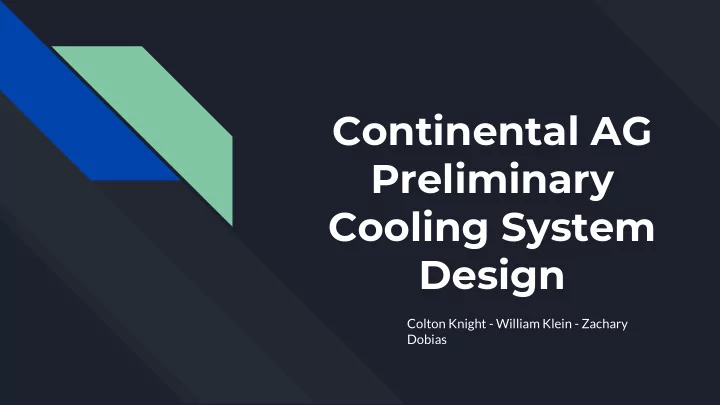

Continental AG Preliminary Cooling System Design Colton Knight - William Klein - Zachary Dobias
Preliminary Task Requirements The cooling system will be ● designed to supply an automated machining line as part of the new plant. The design is created to handle the ● coolant from the time it reaches the plant until the dirty coolant is removed from the premises.
Selection of Materials In the selection of the tanks and pipes ● Example of Materials Subsystem 2 stainless steel was chosen given the corrosive properties of the coolant. A coating was not needed around the ● material due to the minimal corrosive properties of the fluid and to minimize initial expenses. All calculations for both the piping ● systems and tanks have been performed to ensure the materials selected can handle the pressures the system may be subjected to.
Storage Tank Design and Layout The Clean Storage Tank has a volume of ● 16000 gallons and is located on the top of the roof near the train tracks. This will allow for all delivered ○ coolant to be taken from the train. The Dirty Storage Tank has a Volume of ● 10000 gal and is located outside of the building on the ground. The Reservoir tank is located inside the ● manufacturing facility next to the machining area. The size and wall thickness of each tank ● have been selected and proven adequate through the design calculations. https://www.google.com/url?sa=i&rct=j&q=&esrc=s&source=images&cd=&ved=0ah UKEwic4pbWlIXYAhXMSN8KHeRjDEcQjhwIBQ&url=http%3A%2F%2Fwww.lunare ngineers.net%2Fstorage-tanks.html&psig=AOvVaw1uFh7238DFyxzrDrEX_qnp&ust =1513191702008004
Maintenance Considerations Given the necessity to perform maintenance on the cooling system. The time required to ● fill and empty the largest storage tank can be done within a single shift. With the flow rates and times to fill and empty the tanks chosen this allows for more than ● enough time to complete any necessary repairs to the cooling system from wear over time.
Pipe Size and Layout The clean storage tank has been ● elevated to the roof of the facility in order to eliminate the need for an extra pump. The overall layout of the system was designed around this concept. The pipe size, thickness, and layout are ● based on a series of calculations based on the desired flow rate between each system. The routing of the pipes and locations ● of the tanks allow for complete accessibility through the driveway to the facility.
Structural Support Design Structure is a major safety component ● with any design. The number of hangers and distance between them are designed to support the load from the weight of the pipes and forces from the flow of fluid. The pipes will be supported with ● standard clevis hangers. The calculations for the weight and ● windload on the storage tanks have been completed to assist in the development of tank supports by working alongside the civil engineers.
Valves and Fittings The valves and fittings in the system ● were selected to control the flow rate of the fluid and prepare the system in case of failure. The utilization of standard 90 degree ● elbows ensures the initial expense of the cooling system is minimized. Through the use of gate valves the risk ● of experiencing a problem in fluid flow such as a water hammer is greatly reduced. This ensure that anyone operating the valve will not close it too quickly.
Emergency Blind Flange & Open Channel The Open Channel is designed to ● insure that there is a safe and effective way to remove the coolant away from the manufacturing plant in an emergency event that requires the entire system to be drained. Table: Summary of Open Channel Width of Wetted Hydraulic Channel, b (ft) Perimeter, WP Radius, R (ft) (ft) Open Channel 0.3953 0.7908 0.0988
Utilizing Gravity By placing the clean storage tank on ● the roof of the facility, no pump is required as gravity does all the work. This will allow for the reservoir to be filled with 1000 gallons by simply opening a valve. By not using a pump in this subsystem ● the initial expense of the new cooling system will be reduced.
Pump Requirements The requirements for the performance ● of the pump were calculated before the selection of the pump began. By laying out the necessary pump ● characteristics, the selection of the pump type can be proven to require a Kinetic Radial Pump for both pump driven systems. In order to assist the electrical ● engineers, the required power output of the electrical motors have been determined according to the pump requirements.
Pump Selection Given the requirements of the pumps per each subsystem of the design, the actual pumps ● can be selected using the graphs provided by Sulzer. The specific pumps and impeller size have been chosen based on the required pump head ● and flow rate of each subsystem. The efficiency of the pumps has been determined to allow for the calculation of the Net ● Pump Suction Head and proven the pumps selected are capable of meeting the requirements of each subsystem.
Summary of Preliminary Design In the design of the new cooling ● system, the main priority was to create the most efficient layout of the tanks and pipes to minimize complications in maintenance and future problems. This design serves as a preliminary ● layout of the new cooling system to be refined and adjusted as needed to ensure all necessary criteria have been met.
Recommend
More recommend